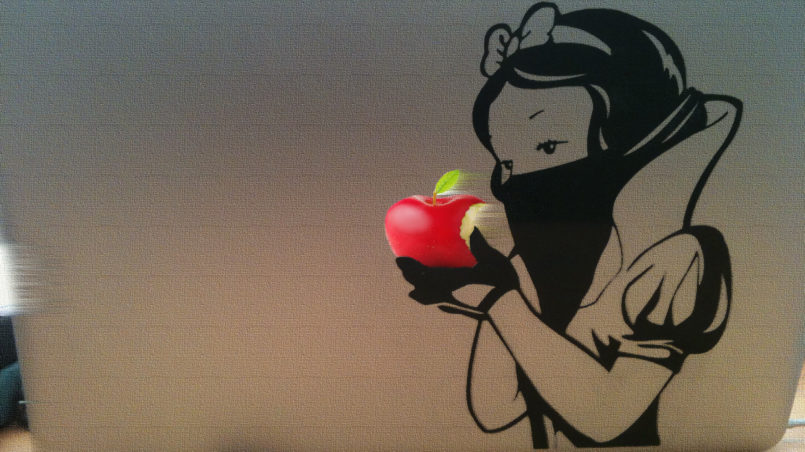The Fairy Tale of the Fairy Tale

When Snow White was offered the poisonous apple, she had no choice
Indeed, the story has to develop from this climax of entanglements from this point of hopelessness, to a happy ending. For the weak and even a little clumsy fairy tale heroes, this is a somewhat uncertain moment, although every listener, reader and narrator knows for sure that this would happen. In fairy tales. In similar, real situations however, everything happens totally differently.
At least we think and say so, when we give ourselves or others wise advice. For a fairy tale is, according to some interpretations, a synonym for the impossible, for the lie, for the illusion.
But, let’s first check if this is indeed true, or whether a fairy tale is also something completely different to the circular rumours about them which they want us to believe. Besides. Every honest reality researcher also has to deal with fairy tales sooner or later.
So what story are we talking about, and what does it tell us specifically?
The goal and the purpose of every fairy tale is to lead the hero to a happy ending, but also that, last but not least, good defeats evil. For this reason alone this pattern has already existed and functioned for millenniums in all nations and cultures.
You have surely, perhaps still as a child, already asked yourself what is a happy ending, what is good and what is evil. And probably you don’t quite understand why we proceed from the climax of entanglements rather that with the beginning of every fairy tale which is so well known to all of us.
A happy ending in the context of a fairy tale means that the person, whom we met at the beginning of the story, although apparently he cannot cope with the misfortune which has befallen him, manages to master all the tasks and conquers the evil and becomes a hero including all of the good deeds, which accompany such a victory. Thereby in the sense of a fairy tale, everything which helps him on his path through the fairy tale to achieve his goal is good (good=pretty=golden) while everything that seems to prevent him from doing so is evil. My dear friends, we began the fairy tale of a fairy tale where we did because this is the decisive point at which the hero is created.
Yes, that is the way a fairy tale is. Very ruthless. There is not much free will, calculations or compromises. For none of the involved. Concerning the structure of the story, the art of storytelling, the scenography and the effectiveness of the tasks of the protagonist, the fairy tale is full of strict rules, enforcements and difficult duties. And this, although it is swarmed with strange events, unusual, magical creatures and objects, which seemingly do whatsoever they wish, without being subject to any rules.
And in the midst of everything the hero is always without exception a person! And not one with pumped up muscles, no suntanned hero from movies or adverts, no injured, mythological half-god and also no rebel or avenger, who arrived on the scene to fight all the inequalities of this world and constantly fights against windmills. The hero is an ordinary, completely ordinary person, who nobody expects to be a hero, and also not that he will have a happy ending or that through him good defeats evil– although this always, without exception always occurs like this. In a fairy tale. And precisely this is the most questionable, the most controversial feature of a fairy tale. Because of this, a fairy tale is understood as inconsistent with reality.
We have of course to stress that, the hero would never have succeeded in reaching his goal if he had not received a magical aid or a magical potion (a creature, e.g. a magical horse; or an object, e.g. a special sword; or knowledge, e.g. where his opponent is weak) somewhere along the way (usually after the false hero has been conquered and after the demands imposed by the giver of the magical potion have been fulfilled) i.e. assistance which at the crucial moment (the decisive fight with his opponent), without any doubt, played a role.
Precisely this appearance of the magical helper and the magical aid corresponds with the place and the moment in the fairy tale where the clumsy person, whom we met at the beginning of the story gets the possibility to apply all of the skills and experiences which he acquired on his way through the story and then he becomes the hero. And for us, the readers or listeners, that is the time and the place of the final correspondence of reality with the fairy tale or however of the conflict between them.
And still we don’t believe these are normal, possible and real since we either have perhaps never, or only very very rarely, witnessed something similar. Possibly only in stories, in dreams, in our fantasies, in films, … Even more so since we usually believe that the magical aid signifies that, out of nowhere, someone or something appears and that this person or thing only has to wave their magical wand in order to solve all our problems.
The magical aid represents our ability to allow miracles into our lives by flowing through the cracks of the solid foundation of daily life. This flowing of the fairy tale into the human reality, however, occurs almost without exception, only at times of adversity – of a problem which it is impossible to solve in the normal fashion or by means of black/white logic that exceeds all personal possibilities and who then casts his gaze above and below, to another higher and deeper dimension of reality.
If we are facing an internal or external wall, a wall which no longer offers us anything but rather demands a fundamental change in us, then all the wheels of our fairy tale mechanism begin to turn and force us to find, accept and apply other solutions. Logical solutions but nonetheless beyond the borders of the logic known to us. Perhaps logical – logical intuitive solutions which reveal themselves in our consciousness in the form of inspiration and deep, universally changing insights. These other logical-intuitive solutions are actually the miracle. These lead to a happy ending …
Then evil is defeated by good … Then we become the heroes of our own fairy tales!
The conclusion (which also C.G. Jung would likely have had no objections to) that we could arrive at at the end of this fairy tale of the fairy tale or as an announcement and beginning of another story would be: somewhere in the deep and more intelligent layers of the human soul, in people themselves, behind the reality and daily life known to them or somewhere above, there is an on-going process which literally follows the story and the structure of a fairy tale. This is why fairy tales affect us as they do.
- Do you believe in fairy tales?
What is your fairy tale?
Do you recognise the inner voice of your magical helper in your daily life?
Do you think that solutions for many human paradoxes are hidden in the ‘Goodnight stories for children’ and that children possibly recognise these solutions logically and intuitively better than adults?
Are you open for new, other solutions? For miracles?
A brief overview of the fairy tale drama which plays on the stage of the human soul
THE ACTIVE ROLES: (Allocated as per W. Propp, an older fairy tale researcher very close to me as regards the topic of fairy tales.)
- Hero (leaves in order to look for something or flees; manages to master the tasks given to him by the giver of the magical potion; fights his opponent and ultimately gets married or is happy)
- False hero (as with the hero, goes in search of something but does not succeed in mastering the tasks given to him by the giver of the magical potion; makes unreasonable demands of the hero)
- Sender of the hero (sends the hero on his way)
- Giver of the magical potion (sometimes gives the hero various tasks to accomplish, gives the hero the magical potion or connects him with the magical helper)
- Counter player (causes damage, hunts the hero and fights with him)
- Sought after person (somehow marks the hero, finds him and recognises him, punishes the false hero, is connected to the wedding and the happy ending – often daughters of kings and their father)
- Magical helper (brings the hero to one place to another, overcomes adversity and shortcomings, he saves the hunted hero, helps the hero to solve difficult tasks and transforms the hero)
STORY LINE
- First act: An unfortunate event happens to the hero, his family or the entire kingdom. The hero sets out (either looking or fleeing)
- Second act: Temptation. The hero meets the provider of the magical potion and the false hero. He fulfils the tasks of the provider of the magical potion and is given the magical potion or a magical helper
- Third act: The hero fights with the counter player and wins (the battle takes place at least 3 times and is each time more ruthless)
- Fourth act: He returns home, received as a hero.
- Fifth act: The hero is given a half or a whole kingdom. Wedding. Party. And they lived happily ever after.
Translation into English: Donna Stockenhuber
Credits
| Image | Title | Author | License |
|---|---|---|---|
 |
Schneewittchen | Patryk Kopaczynski | CC BY-SA 4.0 |
